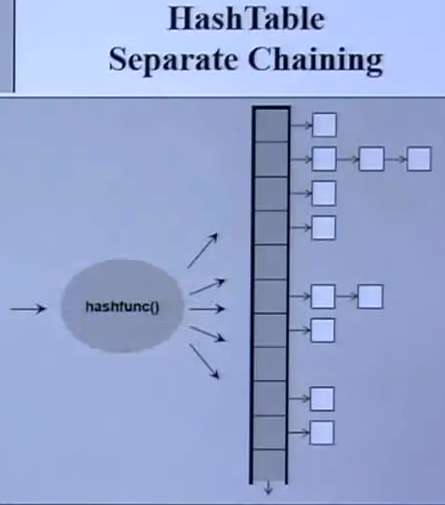侯捷C++STL源码分析
STL六大部件
容器(Containers):放东西,需要占用内存。
分配器(Allocators):支持容器。
算法(Algorithms):操作容器里面的数据。
迭代器(Iterators):容器和算法之间的桥梁,泛化的指针。
适配器(A dapters)
仿函数(Functors)
#include<vector>
#include<algorithm>
#include<functional>
#include<iostream>
using namespace std;
int main()
{
int ia[6] = {27,210,12,47,109,83};
vector<int,allocator<int>> vi(ia,ia+6)//vector<类型,分配器(/*一般不会写*/)>
cout<<cout_if(vi.begin(),vi.end(),not1(bind2nd(less<int>(),40)));//其中cout_if为algorithm,not1为functionadapter(negator) bind2nd为functionadapter(binder) less<int>为functionobject
return 0;
}
复杂度 Complexity,Big-oh
O(1)或O(c)常数时间(constant time)
O(n):称为线性时间(linear time)
O(log2 n)称为二次线性时间(sub—linlear time)
O(n*n)称为平方时间(quadratic time)
O(nnn)称为立方时间(cubic time)
O(2的n次方)称为指数时间
O(nlog2 n):
前闭后开区间

range-based for statement (since C++11)
for(decl:coll){
statement
}
for(int i :{2,3,57,9,13,17,19}){
std::cout<<i<<std::endl;
}
std::vector<double> vec;
...
for(auto elem:vec){
std::cout<<elem<<std::endl;
}
for(auto& elem:vec){
elem *= 3;
}
auto key
list<string> c;
list<string>::iterator ite;
ite = ::find(c.begin,c.end(),target);

list<string> c;
....
auto ite = ::find(c.begin,c.end(),target);
容器——结构及分类
Sequence Contaioners(序列式容器)
Array:数组(c++11增加的,连续空间)

Vector:动态数组(分配器去处理)

Deque:双向队列(先进先出)

List:双向链表

Forward-List:单向链表

Associative Containers(关联式容器)适合快速查找
Set/Multiset(红黑树是高度平衡二叉树,Set放的元素不能重复,Multiset放的元素可以重复)

Map/Multimap(key:value)

Unordered Containers(HashTable)

一次测试程序之辅助函数
using std::cin;
using std::cout;
using std::string;
long get_a_target_long()
{
long target = 0 ;
cout<<"target 0~"<<RAND_MAX<<"):";
cin>>target;
return target;
}
string get_a_target_string()
{
long target = 0 ;
char buf[10];
cout <<"target (0~"<<RAND_MAX<<"):"
cin>> target;
snprintf(buf,10,"%d",target);//把后面的字符串赋值给buf,长度为min(10,后面那个字符串长度)-1
return string(buf);
}
int compareLongs(const void* a,const void* b)
{
return (*(long*)a - *(long*)b);
}
使用容器array
#include<array>
#include<iostream>
#include<ctime>
#include<cstdlib>//qsort bsearch NULL
namespace jj01
{
void test_arry()
{
cout<<"\ntest_array()............\n";
array<long,ASIZE> c;
clock_t timeStart = clock();
for(long i = 0 ; i<ASIZE;++i){
c[i] = rand();
}
cout<<"milli-seconds:"<<(clock()-timeStart<<endl;
cout<<"array.size()="<<c.size()<<endl;
cout<<"array.front()="<<c.front()<<endl;
cout<<"array.back()="<<c.back()<<endl;
cout<<"array.data()="<<c.data()<<endl;
long target = get_a_target_long();
timeStart = clock();
qsort(c.data(),ASIZE,sizeof(long),compareLongs);
long* pItem = (long*)bsearch(&target,(c.data()),ASIZE,siezeof(long), compareLongs);
cout<<"qsort()+bsearch(),milli-seconds:"<<(clock()-timeStart)<<endl;//要使用二分查找之前,数据一定要排序
if(pItem != NULL)
cout<<"found,"<<*pItem<<endl;
else
cout<<"not found"<<endl;
}
}
使用容器Vector
#include<vector>
#include<stdexcept>
#include<string>
#include<cstdlib>
#include<cstdio>
#include<iostream>
#include<ctime>
#include<algorithm>
namespace jj02
{
void test_vector(long& value)
{
cout<"\ntest_vector()..........\n";
vector<string> c;
char buf[10];
clock_t timeStart = clock();
for(long i = 0; i<value;++i)
{
try{
snprintf(buf,10,"%d",rand());
c.push_back(string(buf));
}catch(exception& p){
cout<<"i="<<i<<""<<p.what()<<endl;
//曾经最高i=58389486 then std::dac_alloc
abort();
}
}
cout <<"milli-seconds:"<<(clock()-timeStart)<<endl;
cout <<"vector.size():"<<c.size()<<endl;
cout<<"vector.front():"<<c.front<<endl;
cout<<"vector.back():"<<c.back()<<endl;
cout<<"vector.data():"<<c.data()<<endl;
cout<<"vector.capacity()="<<c.capacity()<<endl;
string target = get_a_target_string();
{
timeStart = clock();
auto pItem=::find(c.begin,c.end(),target);
//find模板函数跟普通函数是一样的。其中双冒号是一个全局的东西
if(pItem != c.end())
cout<<"found,"<<*pItem<<endl;
else
cout<<"not found!" <<endl;
}
{
timeStart = clock();
sort(c.begin,c,end())
string* pItem = (string*) bsearch(&target,(c.data()),c.size(),sizeof(string)),compareLongs);
cout<<"sort()+bsearch(),milli-seconds:"<<(clock-timeStart);
if(pItem != NULL)
cout<<"found,"<<*pItem<<endl;
else
cout<<"not found" <<endl;
}
}
}
//总结:不一定排序+二分查找 查找速度就快。
使用容器list
#include<vector>
#include<stdexcept>
#include<string>
#include<cstdlib>
#include<cstdio>
#include<iostream>
#include<ctime>
#include<algorithm>
namespace jj03
{
void test_list(long& value)
{
cout<<"\ntest_list()....................\n"
list<string> c;
char buf[10];
clock_t timeStart = clock();
for(long i = 0; i< value;++i)
{
try{
snprintf(buf,10,"%d",rand());
c.push_back(string(buf));
}catch(exception& p){
cout<<"i="<<i""<<p.what()<<endl;
abort();
}
}
cout<<"milli-seconds:"<<(clock()-timeStart)<<endl;
cout<<"list.size():"<<c.size()<<endl;
cout<<"list.max_size()"<<c.max_size()<<endl;
cout<<"list.front()"<<c.front<<endl;
cout<<"list.back()"<<c.back()<<endl;
string target = get_a_target_string();
timeStart = clock();
auto pItem = ::find(c.begin,c.end(),target);
cout<<"::find(),milli-seconds"<<(clock()-timeStart)<<endl;
if(pItem != c.end())
cout<<"found,"<<*pItem<<endl;
else
cout<<"not found"<<endl;
timeStart = clock();
c.sort();
cout<<"c.sort,milli-seconds:"<<(clock()-timeStart)<<endl;
}
}
侯捷C++STL源码分析的更多相关文章
- STL源码分析《4》----Traits技术
在 STL 源码中,到处可见 Traits 的身影,其实 Traits 不是一种语法,更确切地说是一种技术. STL库中,有一个函数叫做 advance, 用来将某个迭代器(具有指针行为的一种 cla ...
- STL 源码分析《1》---- list 归并排序的 迭代版本, 神奇的 STL list sort
最近在看 侯捷的 STL源码分析,发现了以下的这个list 排序算法,乍眼看去,实在难以看出它是归并排序. 平常大家写归并排序,通常写的是 递归版本..为了效率的考虑,STL库 给出了如下的 归并排序 ...
- STL源码分析《3》----辅助空间不足时,如何进行归并排序
两个连在一起的序列 [first, middle) 和 [middle, last) 都已经排序, 归并排序最核心的算法就是 将 [first, middle) 和 [middle, last) 在 ...
- STL源码分析读书笔记--第二章--空间配置器(allocator)
声明:侯捷先生的STL源码剖析第二章个人感觉讲得蛮乱的,而且跟第三章有关,建议看完第三章再看第二章,网上有人上传了一篇读书笔记,觉得这个读书笔记的内容和编排还不错,我的这篇总结基本就延续了该读书笔记的 ...
- stl源码分析之allocator
allocator封装了stl标准程序库的内存管理系统,标准库的string,容器,算法和部分iostream都是通过allocator分配和释放内存的.标准库的组件有一个参数指定使用的allocat ...
- STL 源码分析六大组件-allocator
1. allocator 基本介绍 分配器(allocator))是C ++标准库的一个组件, 主要用来处理所有给定容器(vector,list,map等)内存的分配和释放.C ++标准库提供了默认使 ...
- STL 源码分析《2》----nth_element() 使用与源码分析
Select 问题: 在一个无序的数组中 找到第 n 大的元素. 思路 1: 排序,O(NlgN) 思路 2: 利用快排的 RandomizedPartition(), 平均复杂度是 O(N) 思路 ...
- STL源码分析与实现-stl_list容器
1. stl_list 介绍 今天我们来总结一下stl_List, 通过之前介绍单链表的文章,其实对链表的基本操作已经十分熟悉了,那对于stl_list,无非就是链表结构不一样,至于其中的增删改查的细 ...
- STL源码分析之迭代器
前言 迭代器是将算法和容器两个独立的泛型进行调和的一个接口. 使我们不需要关系中间的转化是怎么样的就都能直接使用迭代器进行数据访问. 而迭代器最重要的就是对operator *和operator-&g ...
- STL 源码分析 (SGI版本, 侯捷著)
前言 源码之前,了无秘密 algorithm的重要性 效率的重要性 采用Cygnus C++ 2.91 for windows cygwin-b20.1-full2.exe 下载地址:http://d ...
随机推荐
- LLM(大语言模型)解码时是怎么生成文本的?
Part1配置及参数 transformers==4.28.1 源码地址:transformers/configuration_utils.py at v4.28.1 · huggingface/tr ...
- web 页面/内容 触摸/点击滑动
监听标签的触摸/鼠标滑动事件,添加元素的切换动画,效果如下: 事件监听 鼠标事件和触摸事件监听: 1 componentDidMount() { 2 var teachingReportDiv = d ...
- VS2022使用ClickOnce发布程序本地安装.net框架
因为遇到下面的错误,没有在网上搜到详细解决问题的教程,费了一些时间才解决了问题,特此记录一下,也希望能帮助到其他人. 要在"系统必备"对话框中启用"从与我的应用程序相同的 ...
- 【漏洞分析】ReflectionToken BEVO代币攻击事件分析
前言 BEVO代币是一种Reflection Token(反射型代币),并且拥有通缩的特性.关于Reflection Token更为详细的说明可参考这篇文章.然后目前浏览到的很多分析报告没有指出其漏洞 ...
- 2023-02-16:两种颜色的球,蓝色和红色,都按1~n编号,共计2n个, 为方便放在一个数组中,红球编号取负,篮球不变,并打乱顺序, 要求同一种颜色的球按编号升序排列,可以进行如下操作: 交换相邻
2023-02-16:两种颜色的球,蓝色和红色,都按1-n编号,共计2n个, 为方便放在一个数组中,红球编号取负,篮球不变,并打乱顺序, 要求同一种颜色的球按编号升序排列,可以进行如下操作: 交换相邻 ...
- 2020-10-06:java中垃圾回收器让工作线程停顿下来是怎么做的?
福大大答案2020-10-06: 简单回答:安全点,主动式中断. 中级回答:用户线程暂停,GC 线程要开始工作,但是要确保用户线程暂停的这行字节码指令是不会导致引用关系的变化.所以 JVM 会在字节码 ...
- 一天吃透SpringCloud面试八股文
1.什么是Spring Cloud ? Spring cloud 流应用程序启动器是基于 Spring Boot 的 Spring 集成应用程序,提供与外部系统的集成.Spring cloud Tas ...
- jdg安装及环境设置
1.下载java8 java11 到默认路径 2.右击我的电脑,点击属性 3.点击高级系统设置 4.点击环境变量 5.点击新建 6. 按照提示新建条目 第一个 变量名填入: JAVA_HOME 变量值 ...
- 中文环境下使用 huggingface 模型替换 OpenAI的Embedding 接口
OpenAI的文本嵌入衡量文本字符串的相关性.嵌入通常用于: 搜索(其中结果按与查询字符串的相关性排名) 聚类(其中文本字符串按相似性分组) 推荐(推荐具有相关文本字符串的项目) 异常检测(识别出相关 ...
- docker升级gitlab
昨天在家部署了gitlab,版本居然是15.10,公司版本却是14.6,升级一波. 官方文档: https://docs.gitlab.com/ee/update/#upgrading-without ...
